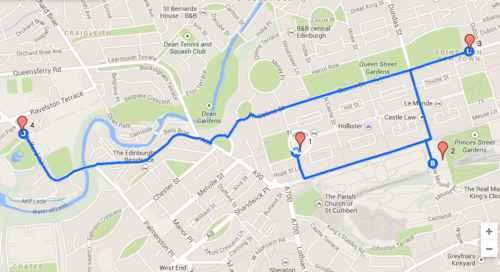
Our Scottish National Gallery walk in central Edinburgh: (1) Hotel; (2) Scottish National Gallery, (3) Scottish National Portrait Gallery and (4) Scottish National Gallery of Modern Art.
Whether you’re new to art or an old hand, Edinburgh is an incredible place for an art visit. The city itself is gorgeous with faded yellow sandstone buildings throughout the new (1800s) and old (medieval) towns, cobblestone streets and closes. From everywhere you catch glimpses of Edinburgh castle perched atop a hill out of which it seems to have grown. No doubt Game of Thrones author George R. R. Martin spent a lot of time here.
Walking around here is a wonder. But just when you think it can’t get better, you visit one of the three museums that make up the National Galleries Scotland and that crown this queen of cities. Three fab and completely distinct museums covering everything Scottish and more. They are within walking distance of each other, and within reach of great eats and plenty of shopping (tartans, whiskey, woollies, crafts).
It’s a bit of a mouthful but the National Galleries are made up of:
- The Scottish National Gallery (including the main gallery and the Scottish Royal Academy that serves as the exhibition hall)
- The Scottish National Gallery of Modern Art (broken down into buildings ‘Modern 1’ and ‘Modern 2’)
- The Scottish National Portrait Gallery
Each is in a different part of town and to experience them properly, lace up the walking shoes. Like Edinburgh (and the Scottish), they are comfortably spectacular because it’s all on a human scale, without pretense.
All three museums are free, and whether you have one hour or several days, make the visit. On the day team Sartle had to leave Edinburgh, we stole 15 minutes in the National Gallery, just as it opened and before we had to run and catch the flight. For a few precious minutes we had the museum’s bright rooms to ourselves, surrounded by the paintings and sculptures so close we could touch them (but we didn’t).
The Scottish National Gallery is the jewel of the three museums. It sits at the end of Princess Street Gardens and if you’re coming from the west, you can take a stroll through the Princes Streets Garden that follows alongside the castle. The Scottish National Gallery is the most comfortable and inviting classic art museum we’ve wandered through. It sits behind the Royal Academy exhibition hall and the two buildings are joined underground, with the connecting passage housing a café, restaurant and museum store. There’s all sorts of unexpected artistic deliciousness here.
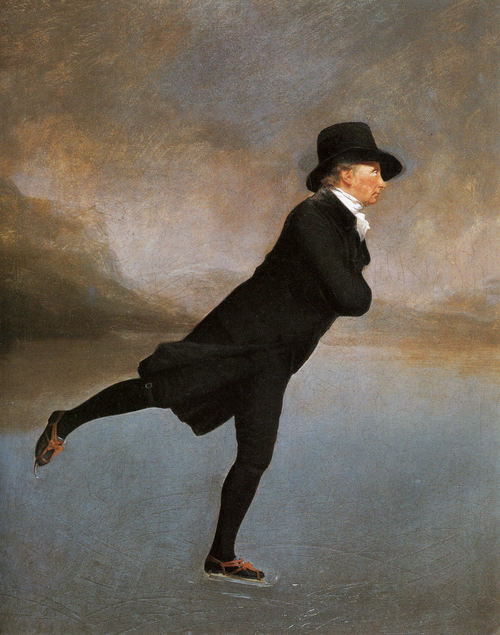
The National Gallery’s star Skating Minister, or The Reverend Robert Walker Skating on Duddingston Loch. Scottish artist Sir Henry Raeburn, 1795.
Monumental in style, the walls are packed with paintings representing centuries of good and great works. Even accompanied by a multitude of white marble sculptures, the effect is surprisingly not crowded. The oblong gallery’s seemingly perfect proportions of height, width, and it’s the deep Victorian claret red walls and hunter green floors give a feeling of space that fits snugly around you, making the walk around intimate (rather than threatening to swallow you up or suffocate you).
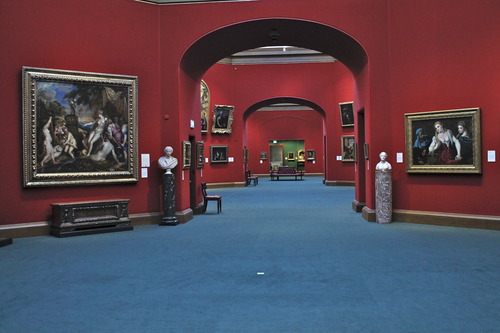
Ah, Victorian colors. Scottish National Gallery main floor. Photo by Ezinda Franklin-Houtzager.
One of the first paintings you see coming in is the unfinished The Virgin and Child with Saint Andrew and Saint Peter by Cima da Conegliano, from late the 1400s. Rather than hide the incomplete acquisition in the furthest corner of the basement, the Scots pragmatically turn this all to their advantage and points out how the piece ‘gives insight into its technique.’ And it does. The completed works by the greats seem to come to us perfect, with little sign of the human labor and imagination that has gone in to their production. The work in progress is the opposite. It shows the tentative ink lines drawn by hand, the difficult decisions ahead to transform the lines into flesh and blood, robes, and verdant nature.
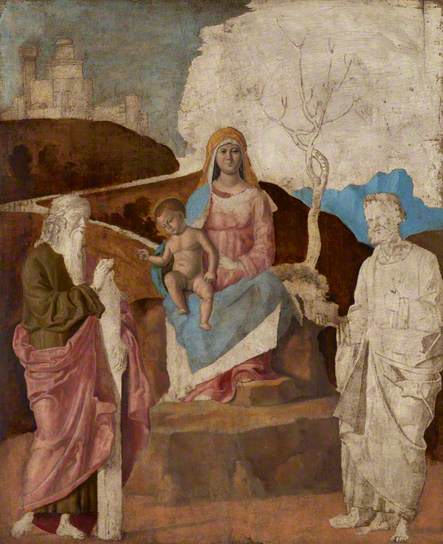
The unfinished Virgin and Child with Saints Andrew and Saint Peter. Cima da Conegliano in the late 1400s.
Next up is the Scottish National Portrait Gallery, a shrine to people Scottish and it’s wonderfully weird. On the way there, be sure to walk down the very cool Hanover street, or on the way back stop in at one of the great pubs and cafes like The Dogs, conceived of by someone who was either batshit crazy or a remarkably vain canine with a strong preference for rooms decorated by family photos and furry friend portraits. Okay, probably someone batshit. The Dogs have a great cook. Anyway, back to the portrait gallery…
One of the first ‘portraits’ that you come across is a bust of Sir Robert Rowand who designed the place in what he called ‘late 13th century gothic.’ Walking into the grand hall is mesmerizing not only because of the beautiful choice of lighting, but also because of a series of murals that cover every bit of surface area. Be sure to stop to watch the Defeat of Hago, King of Norway at Largs. Team Sartle took bets on whether the idea for Stannis Baratheon’s attempted siege of Kings Landing. Minus the wildfire.
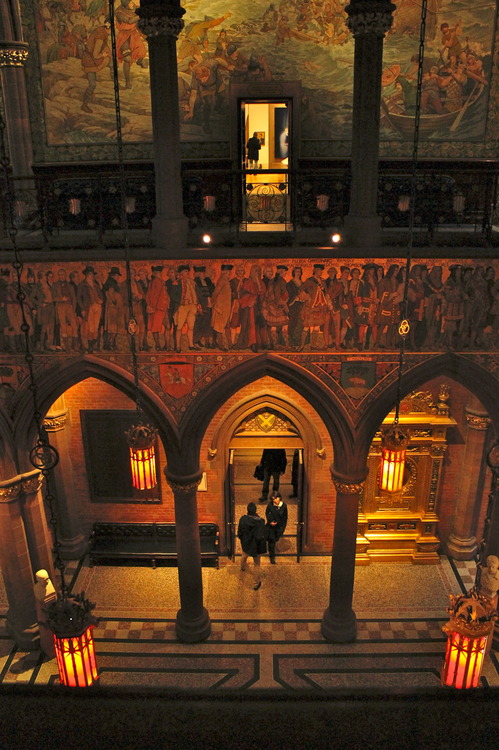
The atmospheric grand hall of the Scottish National Portrait Gallery reveals all of Scottish history from 1649 to 1801. The frieze has 155 great Scottish men and women. William Hole did it all in 1898. Photo by Ezinda Franklin-Houtzager.
Don’t walk into this museum expecting a few photographs and paintings of Scottish historical superstars, though there’s plenty of that. No, when these guys says portrait, they mean busts, phrenology skulls of murderers and killers taken from death masks, a painting of Mary Queen of Scots that turns into a skulls if you move around it, and even a two metre-wide (7 feet) photo of the Queen looking like a rockstar in green velvet and ermine in a field of almost neon-looking pink and green heather. Yeah. You can even add to the madness yourself by completing a ‘portrait’ of Scottish comedian Billy Connelly by recording your own standup routine.
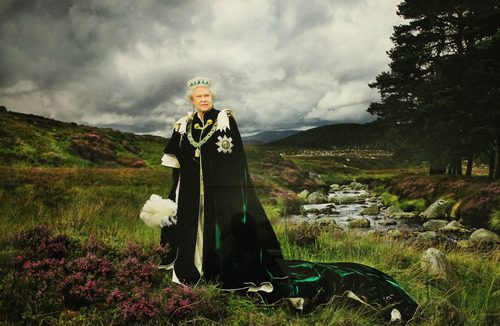
Rockstar Queen Elizabeth II, Sovereign of The Most Ancient and Most Noble Order of The Thistle. We wouldn’t make that up. (132.08 x 203.2 cm) Julian Calder’s photo of 2010.
It’s fair to say that the Portrait Gallery seriously expands ideas of what is a portrait. Here is their eloquent defense of the Gallery’s imaginative take.
On Day 2 we walk along the Water of Leith, a medieval area of coach houses and cobblestone streets and houses built up along the river. Leith must have figured highly in UNESCO’s decision to make Edinburgh a World Heritage City. As you enter the grounds of the Scottish National Gallery of Modern Art from the southern corner of Modern 2. A large lightbulb sign in the field facing the old orphan hospital building signs ‘There will be no miracles here.’ Managing expectations, or maybe a good, somewhat humble, start.
The Gallery of Modern Art is, again, two buildings. Modern 1 and Modern 2 are separated by expansive lawns populated by sculptures and an unexpectedly busy Belford Road.
A guard in standard issue tartan pants braces the entry doors of Modern 2 against the wind with his feet. The space is tight, the corridors narrow. The oak hand railings leading up and down the staircases are dotted with substantial brass nubs to keep the orphans from taking liberties on their way down.
It’s intimate and warm. There is a small store and coffee shop richly stocked in cakes and pastries.
But then we see that the lightbulb display in the field was wrong. There is a miracle here, in the form of, a gargantuan steel statue of Vulcan, the god of fire and the blacksmith who forged weapons for the gods and heroes. He’s 3-stories high and in the middle of the museum coffee shop, rising to the very top of the atrium. It’s probably the only indoor space that could fit him. Geometric strips of metal flesh are welded together. His massive hammer almost touch the walls, the fit is so tight. And walking up to the balcony at the very top, you could look right into his surprisingly tender face. Team Sartle were speechless.
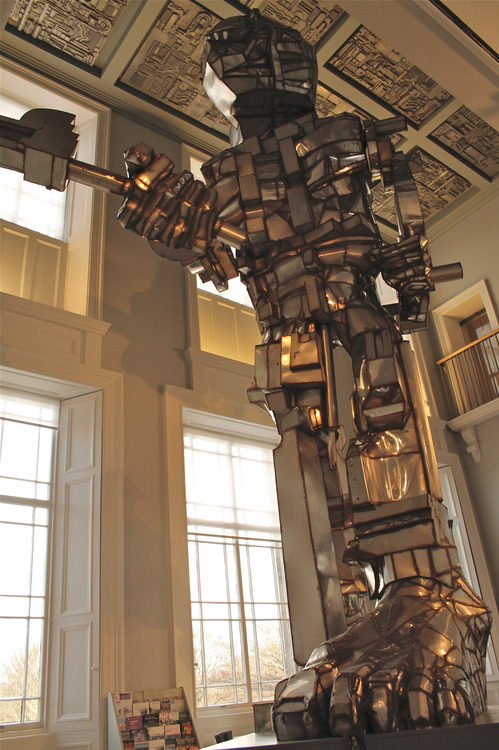
Edoardo Paolozzi’s welded steel god of fire, Vulcan, dwarfs museum coffee shop. 1999. Almost 7 ½ meters or 24 feet high. Photo by Ezinda Franklin-Houtzager.
In fact Modern 2 is dedicated to Italian-Scottish artist Edoardo Paolozzi, creator of Vulcan, who donated all his works upon his death to the nation. This artist completely captured us. Not only is his Vulcan beyond belief, but the insanely cluttered studio where he worked and slept has been moved into the gallery, in its entirety. Modern 1 is by comparison restrained and neatly divided into new acquisitions and exhibitions. But it starts as it means to go on with a neon sign across the top of the neo-classical building reading ‘Everything is going to be alright.’
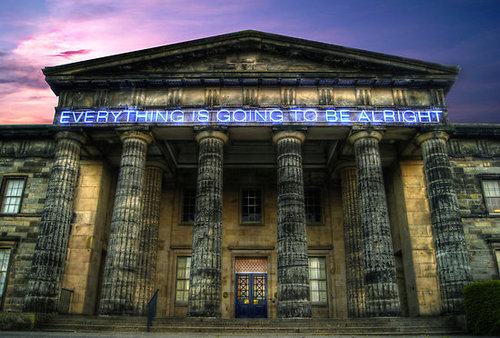
From neoncafe.blogspot.com
And it was. If we’re honest, it was hard to shake off the power of that bloody magnificent Vulcan and the other Paolozzi works and so by the time we got to Modern 1, we were a flat exhausted. No worries. It just gives us an excuse to come back, and do it all again.
By Mrs. & Mr. Rivaat Zarlif









